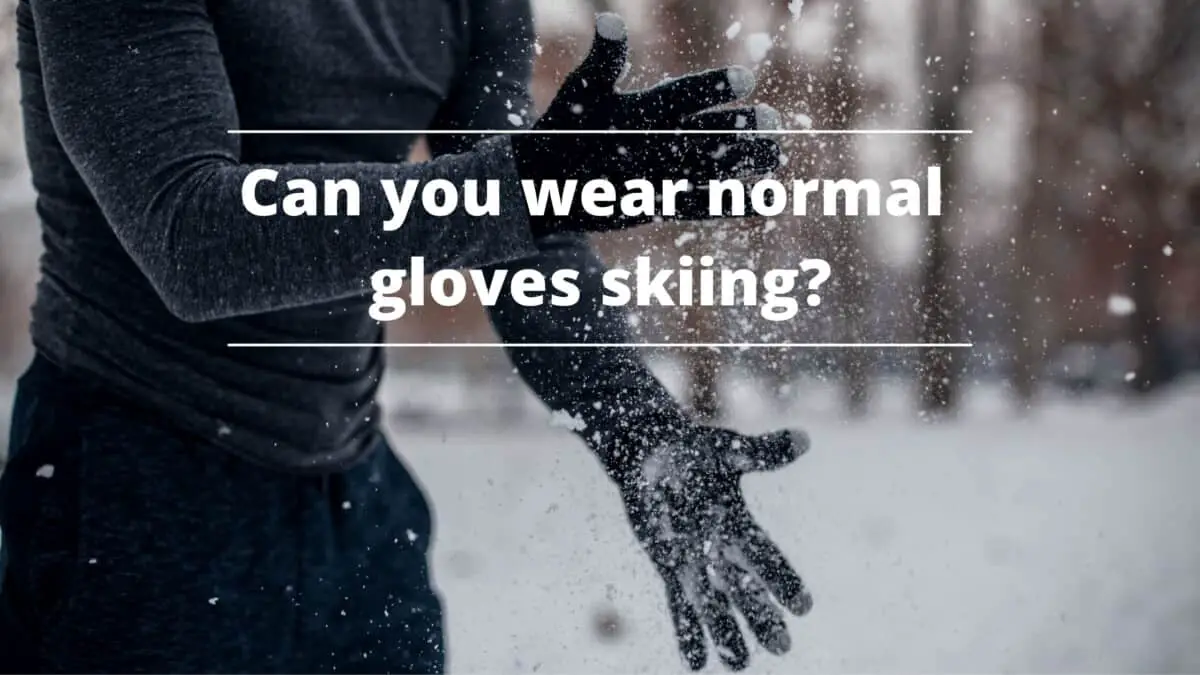Casual winter gloves, or normal gloves, provide light protection against the cold, decent waterproofing abilities, and good features for most winter outdoor activities, but can they be worn for skiing and extreme winter sports?
Wearing normal gloves for skiing will not help you stand up against the extreme and changing weather conditions you will encounter. Thus, it will hinder you from enjoying a good ski day. To help you avoid this situation, we’ve written down everything you need to know to ensure that your hands are protected from the elements.
Are ski gloves the same as snow gloves?
There is not much of a difference between ski gloves and snow gloves. The term “ski gloves” is just used to market a specific type of glove designed for the sport of skiing, but they can still be called snow gloves or winter gloves as they are worn to protect the hands from the snow and cold air.
With this, snow gloves refer to casual winter gloves that are used for walking, running, and other outdoor activities undertaken in cold weather, while ski gloves refer to gloves that are specifically designed for the sport of skiing.
Although choosing snow gloves comes down to personal preferences, feel free to learn more about the different types of gloves, what activities they cater for, and what weather conditions they can handle.
Casual Gloves: Fairly Cold Temperatures
Casual gloves, or normal gloves, are best for daily use in fairly cold weather. They can come in relatively waterproof insulated versions to allow you to wear them while clearing snow from the driveway, building a snowman with your kids, or walking around town.
Snow gloves for daily use can also come in lightweight or fleece models that are not waterproof but can offer light protection against the cold. To class up your winter ensemble, you can choose an elegant snow glove made of deerskin leather.
Depending on when and where you will be using them and how much protection you need, look for features like touch-screen compatibility or flip over mittens with fingerless gloves as they come in a wide variety of styles.
Your hands are extremely susceptible to frostbite. Aside from investing in a quality pair of ski gloves, there are other things that you can do to keep warm. We shared in this article our tips and tricks on how to keep your hands warm while skiing.
Cold-weather Fitness Gloves: Moderately Cold Temperatures
Cold-weather fitness gloves are great for high-output activities like cross-country skiing and cold-weather running. Although these gloves are less insulated than downhill ski or snowboard gloves, they are flexible and breathable enough for winter workouts or activities that require you to be constantly moving.
These gloves may not feel like they are suited for the activity when you are just starting out but they will end up being perfect as you begin to warm up and sweat.
Cold-weather fitness gloves are usually made of a softshell with a DWR finish instead of Gore-Tex. Thus, they do not have the same level of waterproofing as downhill ski or snowboarding gloves. However, they will allow for maximum breathability, which is essential for high-output activities.
For cross-country touring, choose snow gloves with more insulation and excellent to have a solid connection to your poles.
Winter Gloves/Ski Gloves: Extremely Cold Temperatures
These are gloves are designed for activities performed in extreme or freezing weather conditions, including skiing, snowboarding, ice climbing, mountaineering, winter rescue operations, as well as military use, However, there are many things you need to consider before choosing gloves within this category.
Gloves vs. Mittens
Gloves offer better dexterity than mittens due to the separation of each finger from the others. They are ideal for when you need to handle gear frequently, zip up jackets, adjust boot buckles, or hold multiple objects at the same time. Lightweight gloves are best used for cross-country skiing and other aerobic winter sports wherein your body is generating more heat.
Mittens, on the other hand, offer more warmth than gloves as they keep your fingers together without any barrier, and thus, generate more heat. Although they cannot provide the same dexterity as gloves, they still allow you to hold your ski poles, hike in cold temperatures, and carve down the mountain on a snowboard.
If you need much dexterity, then go for ski gloves. And if you prefer optimum warmth, then mittens are a better choice. You do have to consider the quality of the materials and technologies incorporated in the gloves or mittens when choosing what’s best for you and your type of winter activity.
Gauntlet vs. Undercuff
When choosing ski or snowboard gloves, picking a cuff style is also important, although often overlooked. The cuff style helps keep snow out of your jacket and hands, making it another key to keeping you warm.
Gauntlet cuffs are longer and extend past your jacket’s sleeve cuff and cinches at the top to keep the snow out. If you prefer this style of cuff, make sure to check your jacket sleeves’ adjustability as if they are wide and bulky, it will be difficult to stuff them under gauntlet cuffs.
An undercuff style, on the other hand, is one of the most popular choices as it is shorter and usually ends at the base of your wrists. That means it will allow for more mobility than an over-the-cuff style. Although, you do have to make sure that your jacket sleeves are equipped with adjustable tabs for cinching and can open wide enough to accommodate the gloves.
Skiing season is upon us! Whether you’re buying your very first ski gear or just looking to upgrade your old ones, we’ve got the top recommendations for you. Shop for the whole family and check out the best ski gloves for men, best ski gloves for women, and best ski gloves for kids. We have already chosen our top picks and it’s time for you to choose yours.
Materials and Waterproofing
Skiing on the slopes for several hours will bring about very cold temperatures and changing weather conditions, so it is important to look for ski gloves with waterproofing abilities and breathability.
Shell material, lining, breathability, and waterproofing are just a few things to consider when choosing a pair of gloves that will suit you.
Waterproofing is especially important in areas where the snow isn’t as dry. Wet ski gloves will result in cold and damp hands. Fortunately, many good waterproofing materials and technologies are used in ski gloves.
Gore-Tex, Entrant, Omni-Tech, and other technologies provide waterproofing and breathability to ski gloves, along with state-of-the-art engineered textiles that can repel cold and keep the air out.
Standard shell materials include synthetic fabrics or leather, each of which provides its own benefits and disadvantages.
In most cases, leather is more durable, grippy, and naturally water-resistant. However, it is extremely stiff and less functional at first. Leather gloves are also less dexterous and should be treated well for them to function, whereas synthetic materials tend to be more pliable and easier to manipulate, even when newly bought.
Insulation and Breathability
Most high-quality synthetic insulators are tightly woven to make them thinner and provide better warmth while allowing for maximum mobility. Gloves with this type of insulation can be a bit pricey, but if you consider how they can positively affect your comfort, the extra expense will be worth it.
Down insulation is another good option, especially in dry climates. When choosing ski gloves with down insulation, make sure the exterior is waterproof. If not, make sure the gloves are always completely dry because when they get wet, the down loses its insulating properties.
Breathability in ski gloves is also a key feature you should look out for as it will allow much-needed airflow and any sweat or moisture that condenses inside the glove to escape in order to keep your hands dry, warm, and comfortable.
Microfiber, wool linings, and fleece inside gloves have moisture-wicking abilities to keep your hands warm and dry.
Can I wear leather gloves while skiing?
In the ancient world, leather went through a process considered very dirty and toxic. But nowadays, leather gloves go through a more refined process to allow them to be worn while skiing.
However, this depends on the type of skiing and on your level. Leather is a highly durable, naturally water-resistant material, but it needs to be treated to preserve this ability. Although leather gloves must be treated and broken in, most skiers still prefer them as they provide good dexterity, are tough, and can last for many years when taken good care of. If you do choose leather gloves, you have to make sure that they break in nicely and provide some insulation to keep your hands warm and dry.
Winter Gloves Features
-
Handwarmer Pockets
If your hands get easily cold, regardless of your gloves’ insulation properties, you might want to consider a pair with pockets for hand warmers. These tiny pockets are usually found on the top of gloves or at the back of the hand, so that dexterity isn’t compromised. Handwarmer pockets can also serve as vents it gets warmer.
-
Removable Liners
This feature is great for extra warmth and dries faster, which helps with odor control. Liner gloves may come with gloves or be bought separately. Although, you do need to remember that adding liners to your ski gloves can make them too bulky and might cut off circulation if they’re too tight. As for removable liners in mittens, you generally won’t have to worry about this.
-
Touch-screen Compatibility
This feature will allow you to operate smartphones, cameras, or tablets without having to remove your gloves and expose your skin to the cold. Touch-screen compatibility is usually found on light to mid-weight gloves that offer enough dexterity to allow you to control your gadgets. So, if you plan to use your gadgets frequently while out in the cold, it is wise to look for gloves with touch-screen compatibility.
-
Leashes
Leashes will allow you to secure your gloves to your wrists to make sure you don’t drop them while on a chairlift or when you need to have a drink or snack.
-
Battery-powered Heat
Battery-powered heating systems boost warmth in freezing winter temperatures and for anyone who easily gets cold hands. These gloves include rechargeable lithium-ion batteries and can operate on different levels of heat output. Since they operate with the use of batteries and heating technology, they are heavier, slightly bulkier, and more expensive than non-heated gloves. However, if other gloves don’t work for you, those can be worth it.
Do you need ski gloves to ski?
Yes, you need ski gloves while skiing to protect your hands from the outside environment, including snow, cold air, and water. Ski gloves will keep your hands warm in cold weather and can also wick moisture when it gets warmer. It is therefore important that you wear ski gloves while skiing to avoid frostbites, which can lead, in worst-case scenarios, to amputation.
Conclusion
One way of making sure that you will have an amazing day on the slopes is wearing proper clothing that will keep you warm and toasty even when it’s freezing cold outside. Wearing normal gloves while skiing will not provide the optimum warmth and features you need for such an activity. Thus, you must wear snow or winter gloves designed specifically for the activity you are to do.
Remember to consider important features that will help you make the most out of your winter outdoor activity. There are a lot of glove options in the market today which is why it is important that you know what you are looking for before you make a purchase. By doing this, you will ensure that the gloves that you will be getting are a perfect fit for you and your winter outdoor activity.

